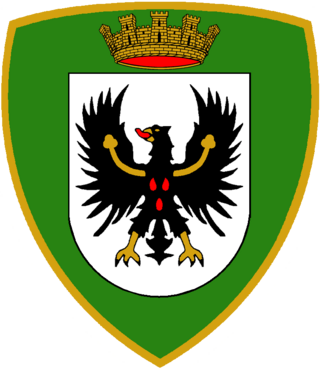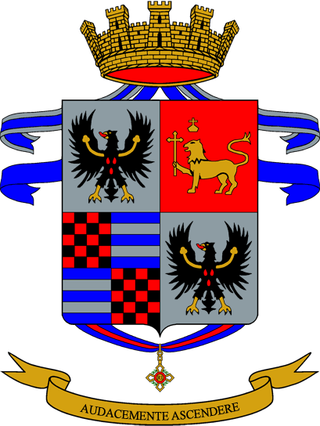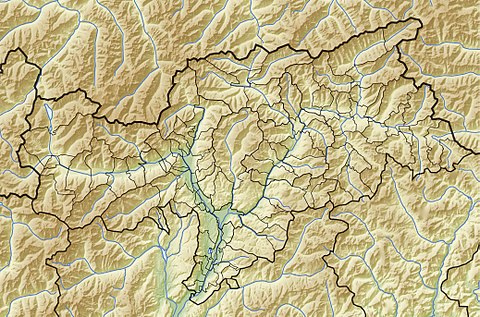
The 4th Alpini Paratroopers Regiment is a special operations forces regiment of the Italian Army based in Montorio Veronese in Veneto. Originally the regiment belonged to the Italian Army's Alpini infantry specialty, but since 14 July 1996 its personnel also belongs to the Paratroopers infantry specialty. On 1 November 1882, the Royal Italian Army formed the 4th Alpini Regiment, which had its recruiting area in the Graian Alps and Pennine Alps. Since 2013 the regiment is assigned to the Army Special Forces Command. The regiment is one of the most often and one of the highest decorated regiments of the Italian Army, although its two Gold Medals of Military Valor were awarded to the regiment's currently inactive Alpini Battalion "Aosta", respectively the currently active Battalion "Monte Cervino".

The 5th Alpini Regiment is a mountain warfare regiment of the Italian Army based in Sterzing in South Tyrol. The regiment belongs to the Italian Army's Alpini infantry speciality and is assigned to the Alpine Brigade "Julia". On 1 November 1882, the Royal Italian Army formed the 5th Alpini Regiment, which had its recruiting area in the valleys of Northern Lombardy, which lie mostly within the Lepontine Alps, Bergamasque Alps and Livigno Alps. The recruiting area of the 5th Alpini Regiment extended to the Westerns shore of Lake Garda, with the recruiting area of the 6th Alpini Regiment commencing on the Eastern shore.

The Alpine Brigade "Cadore" was a light Infantry brigade of the Italian Army, specializing in mountain warfare. Its core units were Alpini, the mountain infantry corps of the Italian Army, that distinguished itself in combat during World War I and World War II. The brigade was based in the Italian provinces of Belluno and Vicenza with its headquarters Belluno. The brigade was disbanded in 1997.

The Alpine Brigade "Julia" is a light infantry brigade of the Italian Army, specializing in mountain warfare. Its core units are Alpini, an infantry corps of the Italian Army, that distinguished itself during World War I and World War II. The brigade carries on the name and traditions of the 3rd Alpine Division "Julia". The division's and brigade's name allude to the Julian Alps in the Friuli region where the division's regiments recruited their troops, and where after World War II the brigade was based. Accordingly, the brigade's coat of arms is modeled after the Friuli region's coat of arms.

The Alpine Brigade "Orobica" was a light Infantry brigade of the Italian Army, specializing in mountain warfare. Its core units were Alpini, the mountain infantry corps of the Italian Army, that distinguished itself in combat during World War I and World War II.

The Alpine Brigade "Tridentina" was a light Infantry brigade of the Italian Army, specializing in mountain warfare. Its core units were Alpini, the mountain infantry corps of the Italian Army, that distinguished itself in combat during World War I and World War II. The Alpine Brigade "Tridentina" carried on the colours and traditions of the WWII 2nd Alpine Division "Tridentina".

The 6th Alpini Regiment is a mountain warfare training regiment of the Italian Army based in Bruneck in South Tyrol. The regiment belongs to the Italian Army's Alpini infantry speciality and is assigned to the Alpine Training Center in Aosta. On 1 November 1882, the Royal Italian Army formed the 6th Alpini Regiment, which had its recruiting area initially in the Vicentine Alps, Bellunes Alps, Carnic Alps, Carnic Prealps, and the Western side of the Julian Alps. In 1887 the regiment was split to form the 7th Alpini Regiment and afterwards the regiment's recruiting area consisted of the Vicentine Alps.

The 9th Alpini Regiment is a mountain warfare regiment of the Italian Army based in L'Aquila in Abruzzo. The regiment belongs to the Italian Army's Alpini infantry speciality and is assigned to the Alpine Brigade "Taurinense". The regiment was formed by the Royal Italian Army on 1 July 1921. In 1935 the regiment was assigned to the 3rd Alpine Division "Julia", with which it served during World War II in the Greco-Italian War, during which the division suffered heavy losses. For its service and sacrifice on the Greek Front the 9th Alpini Regiment was awarded Italy's highest military honor the Gold Medal of Military Valor. In summer 1942 the division was transferred to the Eastern Front in the Soviet Union, where it was destroyed in winter 1942-43 during the Soviet Operation Little Saturn. The remnants of the division were repatriated in spring 1943. For its service and sacrifice on the Eastern Front the 9th Alpini Regiment was awarded a second Gold Medal of Military Valor. On 8 September 1943, the Armistice of Cassibile was announced and invading German forces disbanded the 9th Alpini Regiment.

The 11th Alpini Regiment is an inactive mountain warfare regiment of the Italian Army last based in Bruneck in South Tyrol. The regiment belongs to the Italian Army's Alpini infantry speciality and was last assigned to the Alpine Brigade "Tridentina". The regiment was formed by the Royal Italian Army on 22 December 1935 and assigned assigned to the 5th Alpine Division "Pusteria", with which it participated in the Second Italo-Ethiopian War.

The 18th Regiment "Edolo" is an inactive mountain warfare regiment of the Italian Army last based in Meran in South Tyrol. The regiment belongs to the Italian Army's Alpini infantry speciality and was a training unit last assigned to the Alpine Troops Command. The regiment was formed in 1997 and consisted of the Alpini Battalion "Edolo", whose flag and traditions it inherited.

The 15th Alpini Regiment is an inactive mountain warfare regiment of the Italian Army last based in Chiusaforte in Friuli-Venezia Giulia. The regiment belongs to the Italian Army's Alpini infantry speciality and was assigned to the Alpine Brigade "Julia". The regiment was formed in 1992 and consisted of the Alpini Battalion "Cividale", whose flag and traditions it inherited. The regiment's anniversary falls on 5 January 1943, the day of the Battle of Novaya Kalitva in the Soviet Union.

The 14th Alpini Regiment in a mountain warfare unit of the Italian Army based in Udine in Friuli-Venezia Giulia. The regiment belongs to the Italian Army's Alpini infantry speciality. The regiment was formed in 1993 and consisted of the Alpini Battalion "Tolmezzo", whose flag and traditions it inherited. The regiment was disbanded in 2005. On 1 October 2022, the flag and traditions of the 14th Alpini Regiment were assigned to the Command and Tactical Supports Unit "Julia" of the Alpine Brigade "Julia", which on the same day was renamed 14th Alpini Command and Tactical Supports Unit.

The 5th Alpine Division "Pusteria" was a division of the Royal Italian Army during World War II, which specialized in mountain warfare. The Alpini are a mountain infantry corps of the Italian Army, that distinguished itself in combat during World War I and World War II. The division was formed in 1935 and based in the Puster Valley, which gave the division its name.

The 2nd Alpine Division "Tridentina" was a division of the Royal Italian Army during World War II, which specialized in mountain warfare. The Alpini that formed the divisions are a highly decorated and elite mountain corps of the Italian Army comprising both infantry and artillery units. The name Tridentina was chosen as the division was based in the Trentino-South Tyrol region, for which the fascist regime of Benito Mussolini had created the neologism Venezia Tridentina. After World War II, the traditions and name of the 2nd Alpine Division "Tridentina" were carried on by the Alpine Brigade "Tridentina".

The Comando Truppe Alpine or COMTA commands the Mountain Troops of the Italian Army, called Alpini and various support and training units. It is the successor to the 4º Corpo d'Armata Alpino of the Cold War. The Alpini are light Infantry units specializing in Mountain Combat. The subordinate units of the COMTA distinguished themselves during combat in World War I and World War II.

The 2nd Engineer Regiment is a military engineering regiment of the Italian Army based in Trento in Trentino. The regiment was formed in 1860 and is currently the oldest active engineer regiment of the Italian Army. Since 1954, the unit has been assigned of the 4th Alpine Army Corps and has therefore a strong association with the Italian Army's mountain infantry speciality, the Alpini, with whom the regiment shares the distinctive Cappello Alpino. The regiment is the engineer unit of the Alpine Brigade "Julia" and specializes in mountain combat.

The Alpini Battalion "Tirano" is an inactive mountain warfare battalion of the Italian Army based last in Mals in South Tyrol. The battalion belongs to the Italian Army's Alpini infantry speciality and was assigned to the Alpine Brigade "Orobica". The battalion was formed in 1886 and assigned to the 5th Alpini Regiment. During World War I the battalion fought in the alpine areas of the Italian front. In World War II the battalion fought in the invasion of France, the Greco-Italian War, and on the Eastern Front, where the battalion was almost completely destroyed during the Red Army's Operation Little Saturn in winter 1942–43. On 8 September 1943, the Armistice of Cassibile was announced and two days later, on 10 September 1943, invading German forces disbanded the 5th Alpini Regiment and its battalions.

The Alpini Battalion "Val Brenta" is an inactive mountain warfare battalion of the Italian Army based last in Bruneck in South Tyrol. The battalion belongs to the Italian Army's Alpini infantry speciality and was assigned to the Alpine Brigade "Tridentina". In 1882, the Royal Italian Army formed the Battalion "Val Brenta", which four years later was renamed Alpini Battalion "Bassano". In 1915, the army formed a new Alpini Battalion "Val Brenta", which fought in World War I in the alpine areas of the Italian front. The battalion was disbanded in 1920. In September 1939, the "Val Brenta" battalion was reformed and in June 1940 the battalion participated in the Italian invasion of France. At the end of October 1940 the battalion was disbanded.

The Alpini Battalion "Val Tagliamento" is an inactive mountain warfare battalion of the Italian Army based last in Tolmezzo in Friuli-Venezia Giulia. The battalion belongs to the Italian Army's Alpini infantry speciality and was assigned to the Alpine Brigade "Julia". In 1882, the Royal Italian Army formed the Battalion "Val Tagliamento", which four years later was renamed Alpini Battalion "Gemona". In 1915, the army formed a new Alpini Battalion "Val Tagliamento", which fought in World War I in the alpine areas of the Italian front. The battalion was disbanded in 1920. In September 1939, the "Val Tagliamento" battalion was reformed and in June 1940 the battalion participated in the Italian invasion of France. In November 1940, the battalion was sent to Albania, where the battalion was attached to the 3rd Alpine Division "Julia", which had suffered heavy losses in the Greco-Italian War. In June 1941, after the Invasion of Yugoslavia, the battalion was sent to Montenegro on occupation duty. In August 1942, the battalion returned to Italy. At the end of 1942, the "Val Tagliamento" battalion was sent to occupied France on garrison duty. In July 1943, the battalion returned to Italy and was disbanded.
The Alpini Battalion "Val Cismon" is an inactive mountain warfare battalion of the Italian Army based last in San Stefano di Cadore in Veneto. The battalion belongs to the Italian Army's Alpini infantry speciality and was assigned to the Alpine Brigade "Cadore". In 1915, the Royal Italian Army's 7th Alpini Regiment formed the Alpini Battalion "Val Cismon", which fought in World War I in the alpine areas of the Italian front. The battalion was disbanded in 1919.























